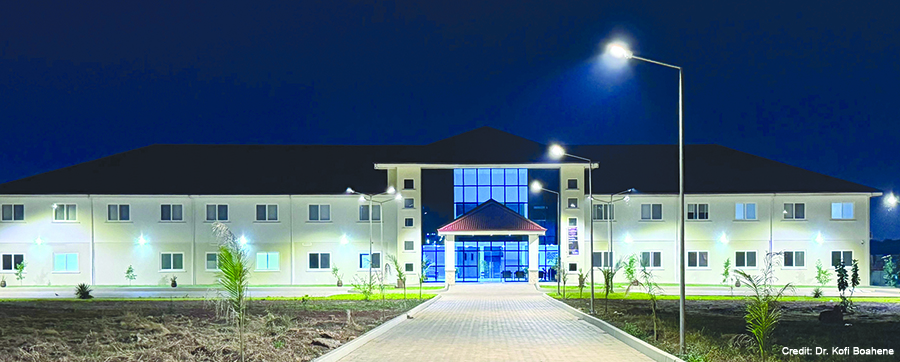Teaming Up to Turn a Dream into Reality
Dr. Boahene had started sharing this dream in the early 2000s while undergoing surgical training at the Mayo Clinic. There, he met Anthony Brissett, MD, a Canadian American citizen born in Jamaica, and Holger Gassner, MD, a German physician who came to the U.S. to study facial plastics. Both men encouraged his ambition and pledged their support.
Explore This Issue
July 2024
Drs. Boahene and Sofola played to their strengths to bring their goal of building a hospital where complex surgeries could be done and local physicians could be trained.
By 2008, Dr. Boahene was making a name for himself at Johns Hopkins and in the wider world of facial plastic and reconstructive surgery. Dr. Sofola was finishing his service with the U.S. Navy and considering his next steps after completing his tenure as the chief of the division of facial plastic and reconstructive surgery at the National Naval Medical Center in Bethesda, Md. Both men were committed to transforming healthcare in Africa and beyond; both wanted to make it possible for African doctors to provide necessary, complex care locally.
Together, they devised a plan.
“We collectively decided that Kofi would stay at Johns Hopkins and become world famous. And I would go to Houston, where I became involved in the construction and management of three physician-owned hospitals,” Dr. Sofola said.
The team knew they’d need lots of money and lots of support to build and staff a hospital in Africa, so Dr. Boahene continued his work at Johns Hopkins, eventually attracting international renown for his ground-breaking work in facial reanimation surgery, his innovations in minimally invasive surgical techniques, and his medical missions to Africa and elsewhere. Dr. Sofola learned the business of medicine from the ground up, navigating local politics, overseeing construction, and managing fiscal operations. He also continued to participate in medical missions whenever possible.

Drs. Sofola and Boahene met as fellows at a national academy meeting in the early 2000s, and this year they realized their dream by opening an 87,000-square-foot hospital in Ghana.
In 2013, CNN highlighted Dr. Boahene as “the doctor who rebuilds faces,” emphasizing both his expertise and his path from Ghana to medical school. In the CNN piece, Dr. Boahene pointedly expressed his desire to pave paths for others.
“There are a lot of children in Africa, just like me, probably more talented, looking for opportunities,” he said. “I got one … I have to carry that back to the continent, the things that I’ve learned.”
He drew additional attention to the problem of African “brain drain” in a 2013 op-ed published by CNN in which he noted that, in the year 2000, “one-fifth of all African-born physicians and one-tenth of all African-born nurses were working overseas.” He also elucidated the importance of moving beyond medical missions to sustainable investment in African infrastructure and used the success of Mayo Clinic to illustrate this vision.
“Having trained at the Mayo Clinic in Rochester, Minn., I am keenly aware of how a small group practice can evolve beyond one generation into a world-renowned medical center,” Dr. Boahene wrote. “The Mayo Clinic developed gradually from the medical practice of a father and his two sons. Resources, skill sets, and expertise should be pooled to establish viable private medical institutions that can survive their founders and expand beyond
